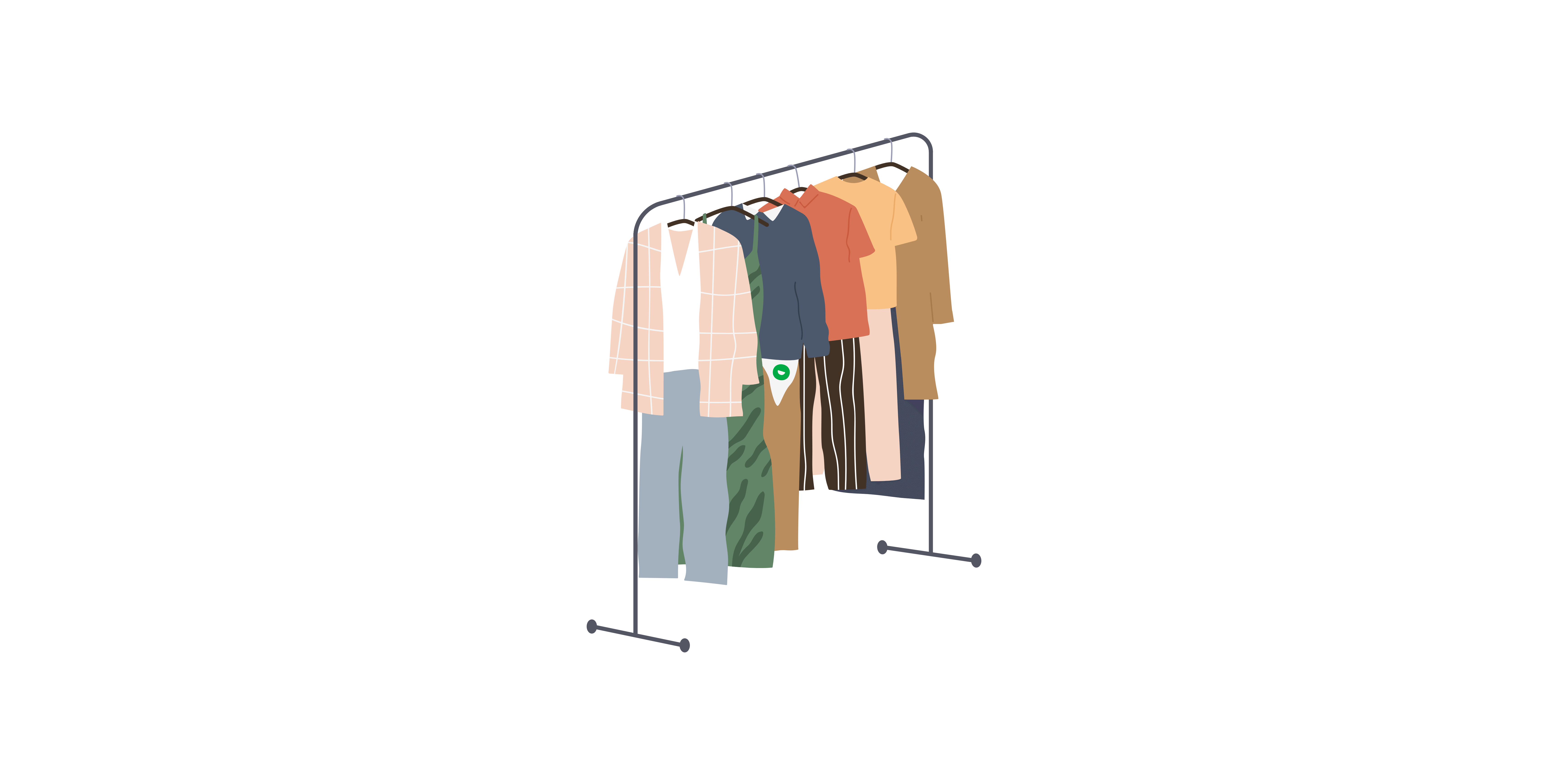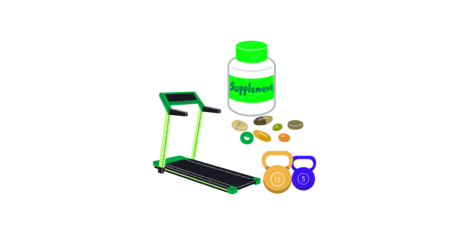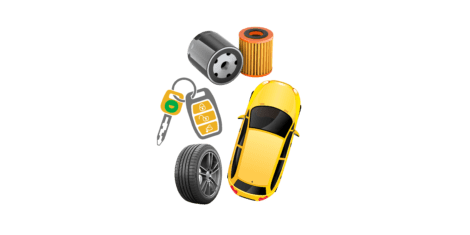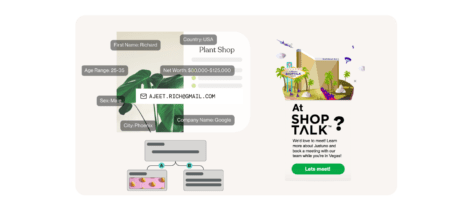Fashion comes and goes by nature—trends change, fads burn out just as quickly as they come, and fashion e-commerce brands need to be agile to keep up with all the changes. It’s a highly crowded and competitive vertical, with newcomers cropping up every day. But that’s no surprise considering the fashion market is valued at $775 billion (including apparel, accessories, and footwear). It’s the number one e-commerce sector in the world with projected growth to over $1.2T by 2025.
To break it down for you, that means that 29.5% of all e-commerce sales in the US are apparel & accessories. And while the US may only be the second largest market for fashion sales—it’s considerably farther ahead than its nearest competitor.
It’s clear that in order to succeed in this massive market, e-commerce fashion brands must stand out from the competition. And the best way to do that?
Through a dialed-in website experience and promotion strategy that’s personalized and seamless for every shopper.
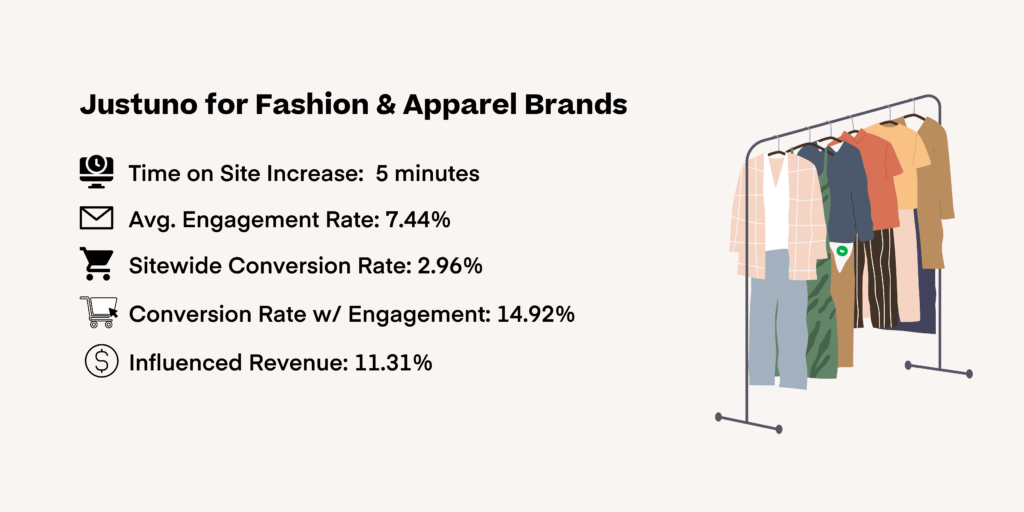
Unlike other industries, fashion can be a frequent purchase, and while some brands have cultivated intense loyalty—many have not. This is why it’s critical to delight visitors right from the start when they come to your website. Start with a solid foundation of lead capture and data collection, and from there, increasingly personalize their experience with your brand to keep them coming back again and again.
Fashion and apparel brands using Justuno see an average 5-minute increase in time on site when a visitor is engaged with a promotion, going from around 2.78 minutes to 7.64. Their average engagement rate with promotions is around 7.44% and for lead capture hovers at 5.84%. Fashion and apparel brands convert overall at around 2.96%; however, this jumps up to 14.92% after visitors engage with a promotion. This is a 404% increase in conversion rate that’s due to the strategic use of messaging that provides relevant customer experiences and personalized touchpoints.
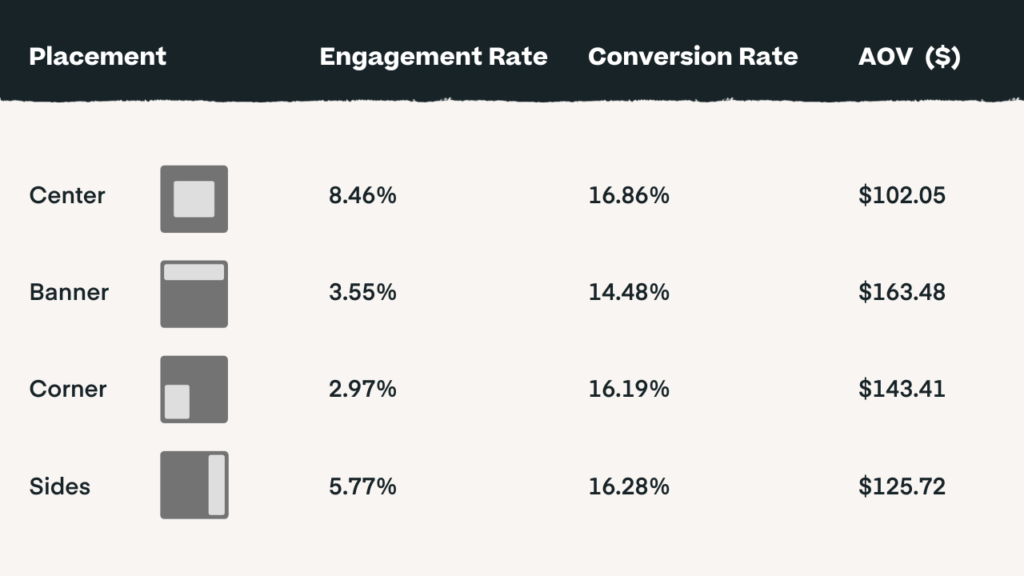
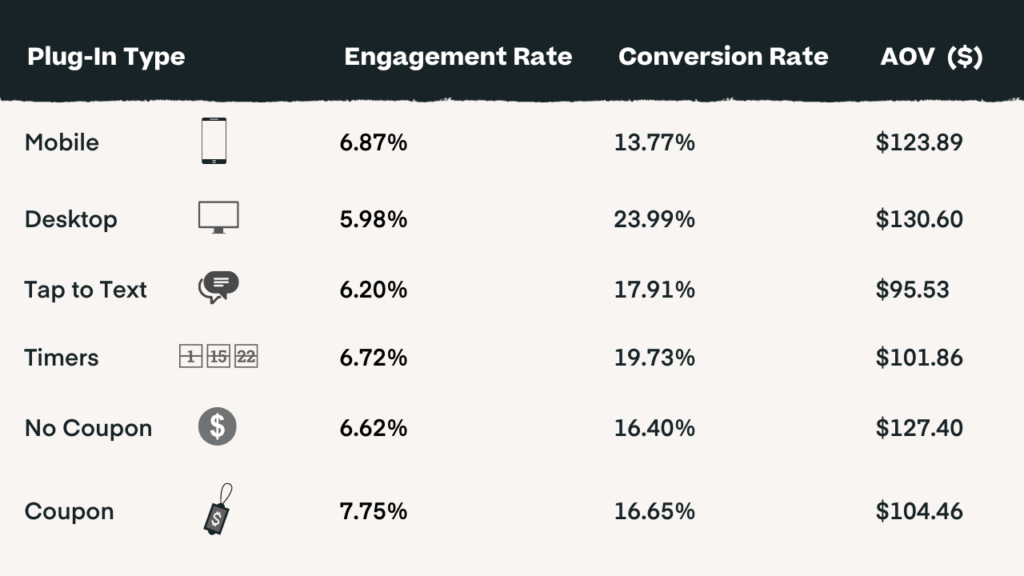
Let’s dive into some real-life examples alongside suggested use cases for fashion and apparel brands looking to convert more website visitors into customers.
1. Enhanced Lead Capture: Additional Info
One of the most foundational parts of your onsite experience to set up is the lead capture. Lead captures represent an opportunity to be so much more than a simple email or SMS opt-in, especially for fashion and apparel brands.
You can use lead captures to let visitors indicate what kind of clothing they’re looking for (ex. mens or womens), which can improve relevance in subsequent emails (AKA the welcome series!). Additionally, if you’re already sure of what kind of clothing they’re shopping for (i.e you only sell men’s clothes)–you could use lead captures to get an idea of what products or styles they’re looking for.
A great example of this in action is on American Tall’s website. Their (Justuno) lead capture is used to collect the type of clothing the visitor is looking for, along with a rotating graphic showcasing all their clothing options.
This is a great way to send traffic to product pages that are most relevant for them, improving the chance of conversion. Additionally, you can use this zero-party data to segment subscribers in your ESP and SMS campaigns for more relevant messaging off-site.
2. Gamification
Gamification is a great option for fashion e-commerce brands because it’s fun, gives an opportunity to showcase brand personality, and makes a lasting impression. To start, you can go the traditional route with a spin to win pop-up or dive into custom promotions with a mystery prize or scratch-off that are sure to delight site visitors.
A great example of this is Justuno customer DIFF Eyewear; their mystery prize lead capture below has a clean design, four possible options, and an eye-catching movement designed to immediately engage the visitor.
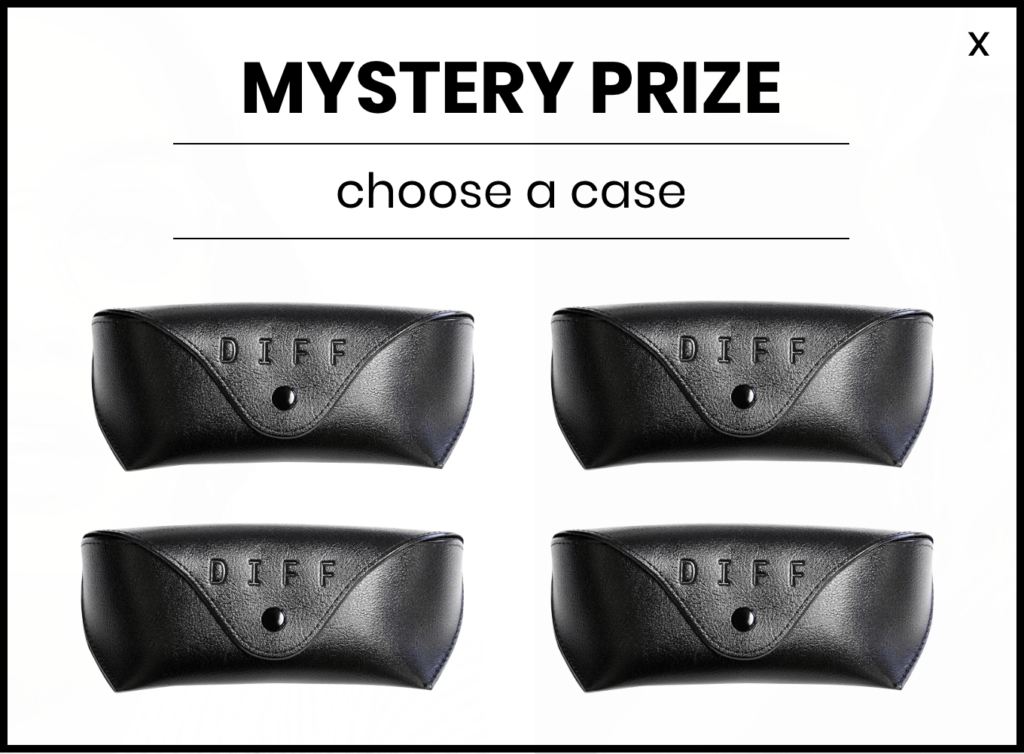
Spin to wins average a 9.26% engagement rate for fashion and apparel brands, converting 11.54% of those engaged visitors into customers. This makes them and other gamified promotions a great way to build your email list quickly with a high conversion rate, all while giving your visitors a fun experience.
3. Out-Of-Stock Sign-Ups
No industry is immune to the supply chain and shipping delays we’ve been experiencing over the last few years. Whether you’re having trouble getting inventory from suppliers, a product went unexpectedly viral, and you sold out in three hours –it’s not the end of the world!
Use this as an opportunity to collect sign-ups from visitors who’d like to be notified when it comes back in stock. We recommend using faster channels like SMS marketing or push notifications for out-of-stock notifications since it’s a time-sensitive message, and people will want to get theirs before it’s gone again! Remember, urgency sells.
However, the best option is to give the shopper the power of choice by not only letting them choose their preferred channel but also providing a more relevant notification experience by selecting the size and color of the item they want. Nothing is more frustrating than getting a back-in-stock email only to click through and realize it’s not back in your size! This extra attention to detail can elevate brands and create substantial customer loyalty.
4. SMS Lead Captures: Tap-to-Text
Fashion brands that use Justuno’s tap-to-text feature for collecting SMS opt-ins for mobile traffic are seeing great success. The opt-in rate for these promotions is 6.2% (higher than the industry opt-in average), and 17.91% of those subscribers end up converting!
This is the easiest way to grow your SMS list with just two taps for visitors to opt-in—if you’re a fashion brand that’s already using SMS or is looking to start, make sure to use tap-to-text to collect those opt-ins to maximize not only your list size but your conversion rate!
5. Lead Captures: Instagram/TikTok Handles
Fashion and apparel brands rely predominantly on exceptional visuals, and there’s nothing more visually powerful for consumers than seeing your products on real people, i.e., user-generated content (UGC).
For e-commerce fashion brands, collecting Instagram and TikTok handles is just as, perhaps even more, important as emails or phone numbers. Sync these handles to an influencer marketing platform like Gatsby to identify your customers who have influence and may be good for your ambassador program with an automated journey from activation to compensation.
From rewarding UGC posts with loyalty points to resharing the content and even building a formal influencer marketing partnership—it all starts with collecting handles.
Justuno customer Moana Bikini added a secondary field to their email lead capture for collecting Instagram handles and had 68.9% of those who signed up for emails also provide their Instagram.
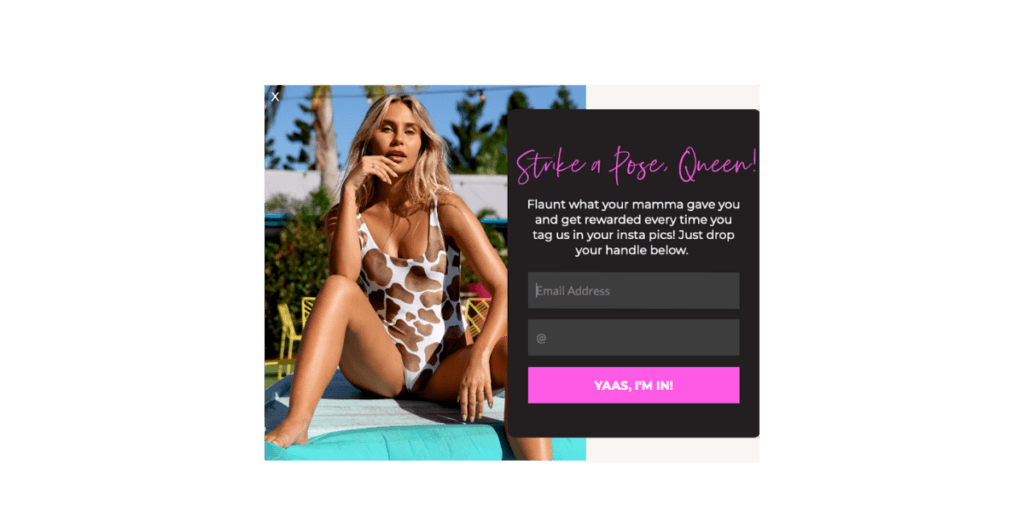
6. Influencer-Specific Targeting: Greetings
If you are working with influencers, then you’re well aware of the opportunity they provide fashion e-commerce brands—but are you making the most out of these campaigns?
Create a promotion for each influencer you work with to greet their audience and mirror messaging onsite (for example, their name, exclusive discount code, etc) via UTM targeting. This is a small but impactful way to start personalizing their followers’ experience from the start. If you really want to take this to the next level, use the influencer’s content in the promotion for instant recognition!
7. Influencer-Specific Targeting: Product Recommendations
In addition to a welcome pop-up greeting influencer traffic, create a product recommendation carousel targeting this traffic, suggesting other products that were part of the campaign or content. Use wording like “Dani’s Favorites” or “Get Dani’s Outfit” to drive home the personalization and generate FOMO amongst their followers.
8. Audience Sync: Retarget New Subscribers
For all your lead captures, set up Audience Sync to get even more out of these new subscribers. Audience Sync allows you to automatically send subscriber info to Google and Facebook audience managers for retargeting segments, prospecting lookalike audiences, and improving overall campaign performance. This can be a game-changer for fashion brands to bring back window shoppers or simply stay top of mind while someone shops for an event. Show additional creative like social proof based on products browsed to move shoppers down the funnel more efficiently.
Hint: This is where UGC can be a big help—ads created with UGC boast 4x higher click-through rates at 50% less cost per click, and they’re more cost-effective to produce.
9. Paid Ads Mirrored Campaigns
For your ads on Instagram, Facebook, TikTok, Google Shopping, etc., you’ll want to create campaign-specific promotions corresponding to their messaging. Greet this traffic with mirrored content (keyword, offer, etc.) from what drove them to click in the first place. This easy access to their code/coupon, seeing the word(s) they searched, similar visuals, etc., will drive instant recognition and personalization.
Pro Tip: Did you know? Justuno’s Audience Sync seamlessly connects with your Google and Facebook ads. Learn More.
10. Virtual Showroom
For e-commerce fashion brands, it’s important to provide an ‘in-store like’ experience but that becomes even more important at higher price points where a 1:1 connection is crucial to conversion. Using platforms like Feel, which provides virtual sales experts in online showrooms that natively integrate into storefronts, is the answer. But how do you promote this seamless shopping experience? Through a pop-up, of course!
That’s exactly what high-end fashion brand Ruti did by embedding a short video in a pop-up that appears on their website to draw attention to their showroom and engage visitors. They experienced a 210% increase in conversion rate when this pop-up was engaged with, and their virtual showroom increased AOV by 78% while decreasing return likelihood by 80%!
11. In-Page Product Recommendations
For fashion brands that have blogs—adding product recommendations directly into articles can be a game-changer for getting more out of organic traffic coming to those pages.
Whether you’re writing about a winter capsule wardrobe and linking the pieces you’re talking about or creating gift guides for holidays,in-page product recommendations will save the day. These are a great way to provide easy access to readers to the products they’re learning about while decreasing the likelihood of browse abandonment or distraction.
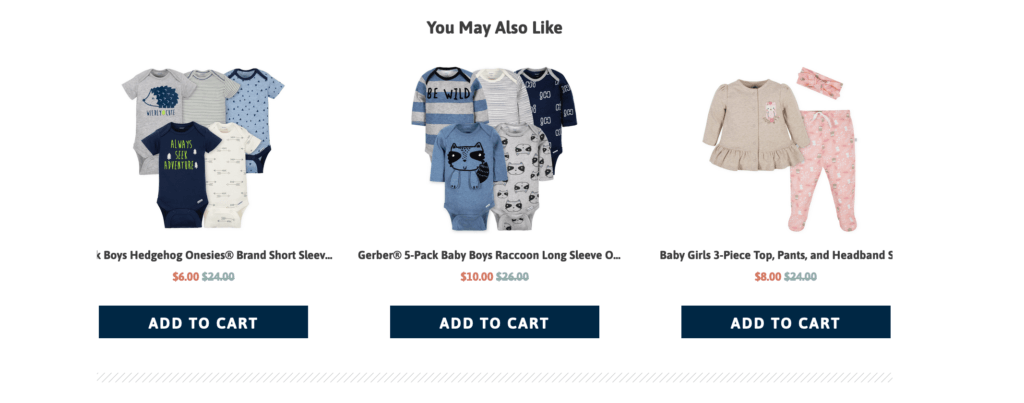
A great example of this in action is on Justuno customer Gerber’s website—their in-page product recommendations at the end of blog posts are a game-changer for parents who are on the move and need to learn/shop quickly for their kids’ clothes.
12. Product Page Recommendation Carousel
Product recommendations are most commonly found on product pages, and for good reason! This is where you can show shoppers complementary and related products they might be interested in, increasing their page count and ultimately driving them toward conversion. Don’t miss out on this as a fashion brand, and make sure to suggest related items based on color, type, or even collection to maximize engagement.
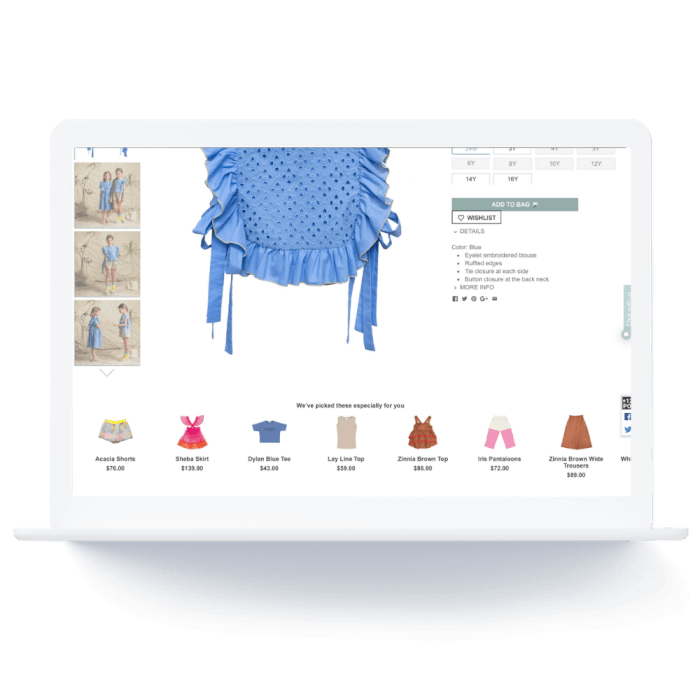
13. Add to Cart Cross-Sell
Once a shopper has added something to their cart, you can trigger a Justuno product recommendation to appear in a pop-up immediately. Use this for a free gift option or simply to cross-sell related/complementary items. If they’ve just added a swimsuit top to their cart, maybe they need the matching bottoms or a coverup to go with it. It never hurts to provide the option.
For fashion brands, this can be most effectively framed as a “Complete the Look” carousel. When someone adds an item to their cart, trigger a carousel featuring all the other items in the outfit shown in the product photos—this is a strong incentive on its own, but you can add an offer or exclusive discount on the full outfit to drive same-session sales.
14. In-Cart Add-Ons
For fashion brands who prefer to go the in-cart route with product recommendations, that works just as well! Use the cart page or slide-out cart to place low-profile recommendations based on shopper behavior, cart content, best sellers, etc.
This is great for last-minute add-ons and impulse purchases but can be effective as well for larger items! A/B test to see if a smaller accessory is more enticing than a larger item to complete the look.
15. Shipping Threshold Banners
The cost of shipping has been on the rise, which, for many clothing brands, can be a huge factor in profit margins. Lower AOVs can eat into profit margins with free shipping, which is something consumers increasingly expect. If this is a struggle for you, we suggest offering free shipping, but only at the order value that makes it profitable for you. Let visitors know by using dynamic shipping banners that show how much more they need to spend to unlock free shipping.
You’ll reduce abandoned carts by letting visitors know ahead of time that shipping isn’t always free; plus, as they shop, the banner automatically updates, creating a more personalized, dynamic experience.
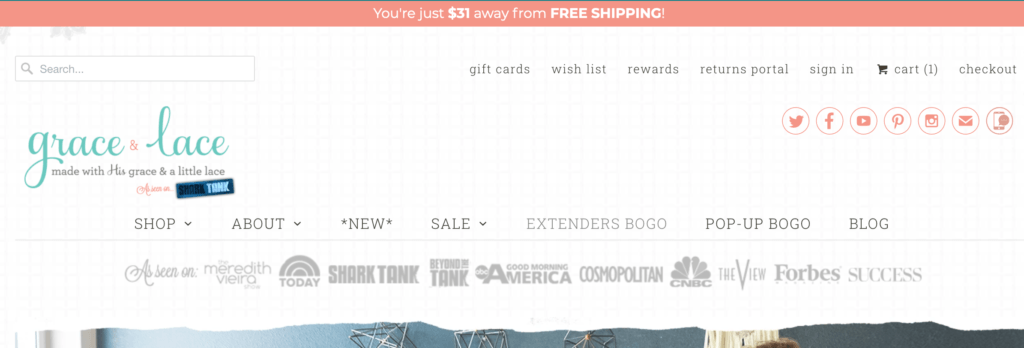
16. Geo-Targeting
If you are in local boutiques (or have brick-and-mortar locations), create geo-targeted pop-ups showing only to visitors within a specific area. Justuno can narrow all the way down to the zip code, so you can be exceptionally granular with these. Options include:
- Cart abandoner to find local stores (great if shipping timelines are a concern)
- Buy online, pick up store for faster fulfillment
- Finding out-of-stock colors or sizes in stores
- Shipping delays for different areas. This is crucial for transparency with shoppers, as delays in orders for clothes can be frustrating for shoppers if they are for a specific event or holiday. Communicate to visitors in areas where you’re experiencing delays, with a banner informing them of this, to build trust and transparency.
17. Exit Offer: Product Finder
Sometimes, the sheer number of choices can be overwhelming to a customer, or if they’re unsure of what is the right choice for their closet—it can be easy to simply leave your site.
A great tool here for product education (and a chance to collect zero-party data)–is to use a product finder quiz on an exit offer. Usually, this works best for fashion brands with a varied target audience, specialty designs, or large product catalogs.
Using a quiz as an exit offer can provide more value than a discount code since these shoppers are looking for education and information!
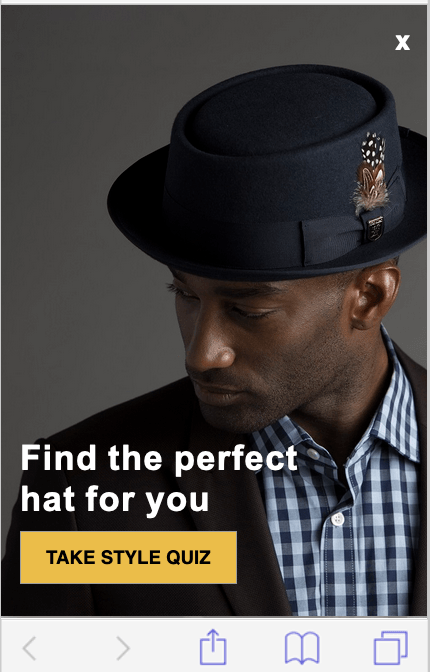
18. Cart Abandoner: Reviews
One of the biggest roadblocks for shoppers online when it comes to clothes is being unsure about the fit or how the product really will look in person. Use a testimonial for social proof giving them confidence that piece of clothing is right for them.
Find reviews that specifically mention how things fit or their quality and combine that with some great UGC from your reviews section. Then create a version of this cart abandoner for different shopping segments (this may be harder if you have a large product catalog). Use Justuno’s advanced targeting rules to set this up to trigger based on certain products (Shoes vs. Dresses)–so that those with certain products in their cart will get their own experience.
19. Cart Abandoner: Returns Policy
Shopping online for clothes is much harder to justify a conversion on if you’re unsure about the fit and the returns policy isn’t clear. If you have a free and easy returns process or satisfaction guarantee—this is the ideal point to showcase it. The shopper is interested enough to add items to their cart but just weren’t quite sold yet.
Proactive returns policy knowledge or a guarantee is perfect for this segment; reiterating the no-risk aspect of their purchase removes barriers or hesitation to drive same-session conversions without reducing profit margins. Combine with a timer for maximum FOMO and to drive immediate action.
20. Cart Abandoner: BNPL
Buy now, pay later (BNPL) technology is increasingly common on e-commerce sites, including fashion and apparel. Consumers love the easy four installments, and for those with higher price points, this is a great way to help consumers afford their carts. Make sure to prominently display this option at various stages on your website, but if someone goes to abandon a cart over a certain dollar amount, fire an exit offer reminding them to buy today and pay over time.
Payment platforms have turned into conversion funnels themselves, and having them can be the difference between making a sale and losing out on a customer. Even if you do not want to leverage BNPL, one-click checkouts like ShopPay, AmazonPay, or Paypal make checkout easier for customers and can streamline your BOFU.
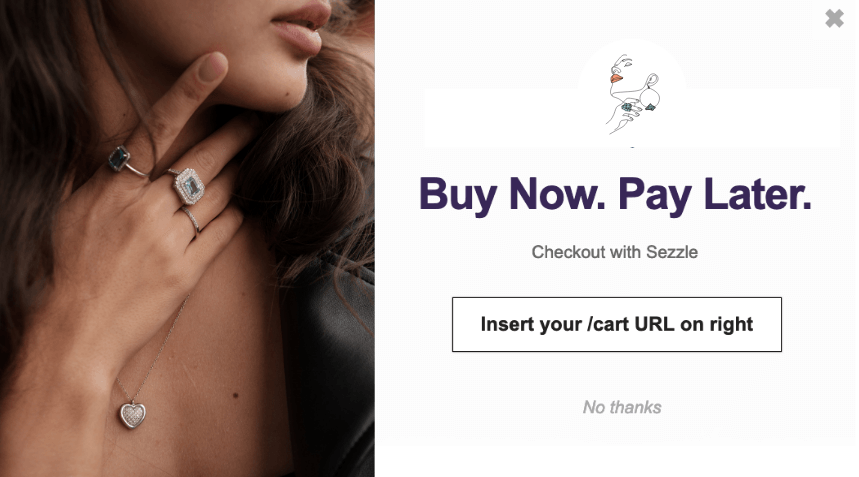
21. Returning Cart Abandoner
If a shopper abandons their cart but ends up returning—use a side or corner promotion to remind them of the really cool outfit they left behind! Dynamically pull in the product image, name, and price to the promotion, along with a CTA taking them directly to checkout.
This personalization makes it easy for them to convert without having to go back and re-add items or look at their cart. Just one click and they’re already at the point of conversion!
22. Loyalty Program Sign-Ups
Loyalty programs are one of the best ways to gamify retention for a consumer making it fun and easy to rack up rewards. If a customer checks out but isn’t logged in—show them a promotion encouraging them to sign up and earn something from today’s purchase, like double points or a free gift added to their shipment, etc.
Since we know it can be difficult for some fashion brands to build strong customer loyalty, retention plays are crucial in strengthening relationships and providing customers a reason, beyond your fabulous designs, to come back.
23. Membership or Loyalty Program Products
In the same vein as collecting program sign-ups, you can target returning customers who purchased before but haven’t signed up for your loyalty program. Similar to how a vitamin brand might target non-subscribing customers, you can target these shoppers with exclusive products to access or VIP colors. You could also use this as an incentive for lead captures earlier in the customer journey—everyone loves a limited edition color or item to make them feel special!
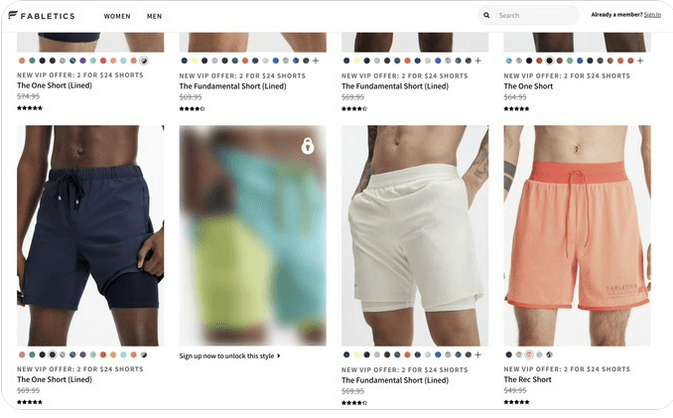
24. Non-Discount Alternative: Gift Cards
While coupons are very common for fashion brands and successful for driving engagement, promotions without a coupon were engaged with less than one that did. They’re not necessarily the only option; in fact, traffic that engaged with a promotion without a coupon converted at nearly the same rate as traffic that had a coupon and with a higher order value ($127.40).
A great option for a fashion brand that is not using a coupon is to leverage a gift card. And the best way to do this is via a threshold banner—specifically to drive up average order values to unlock it! Use messaging like “Spend $300 and get a $50 gift card” with the right order total and gift card amount for your profit margins.
This is a great strategy to use during BFCM to drive repeat purchases or encourage those shopping for others to save a little something for themselves to use later on.
25. Post-Purchase: Additional Channel Opt-Ins
Did you know that order tracking pages are checked an average of five times between when an order is placed and when the customer receives it? That makes post-purchase one of the most important touchpoints in the customer journey! You’re setting the stage for their relationship with your brand before they even receive the products and, hopefully, a repeat purchase.
Use this page to collect additional channel opt-ins that a customer hasn’t signed up for yet. This could be SMS, Instagram, TikTok, etc., as a secondary channel to retarget and engage them on. For SMS, use messaging like “Get order updates”; for Instagram/TikTok, say “Tag us in our #ootd,” etc. By encouraging them to interact with your brand on other channels, you’re deepening the relationship and keeping your options open for the future.
Pro Tip: Check out how one fashion/apparel retailer did that with Justuno and Malomo to increase post-purchase engagement 22%!
26. Post-Purchase: Product Recommendations
If you’re all set on channel opt-ins, use these order tracking pages to sow the seeds of interest for their next purchase. Place in-page product recommendations based on their order contents to get them looking at your other clothes. If they purchased just the workout top, show matching shorts or leggings.
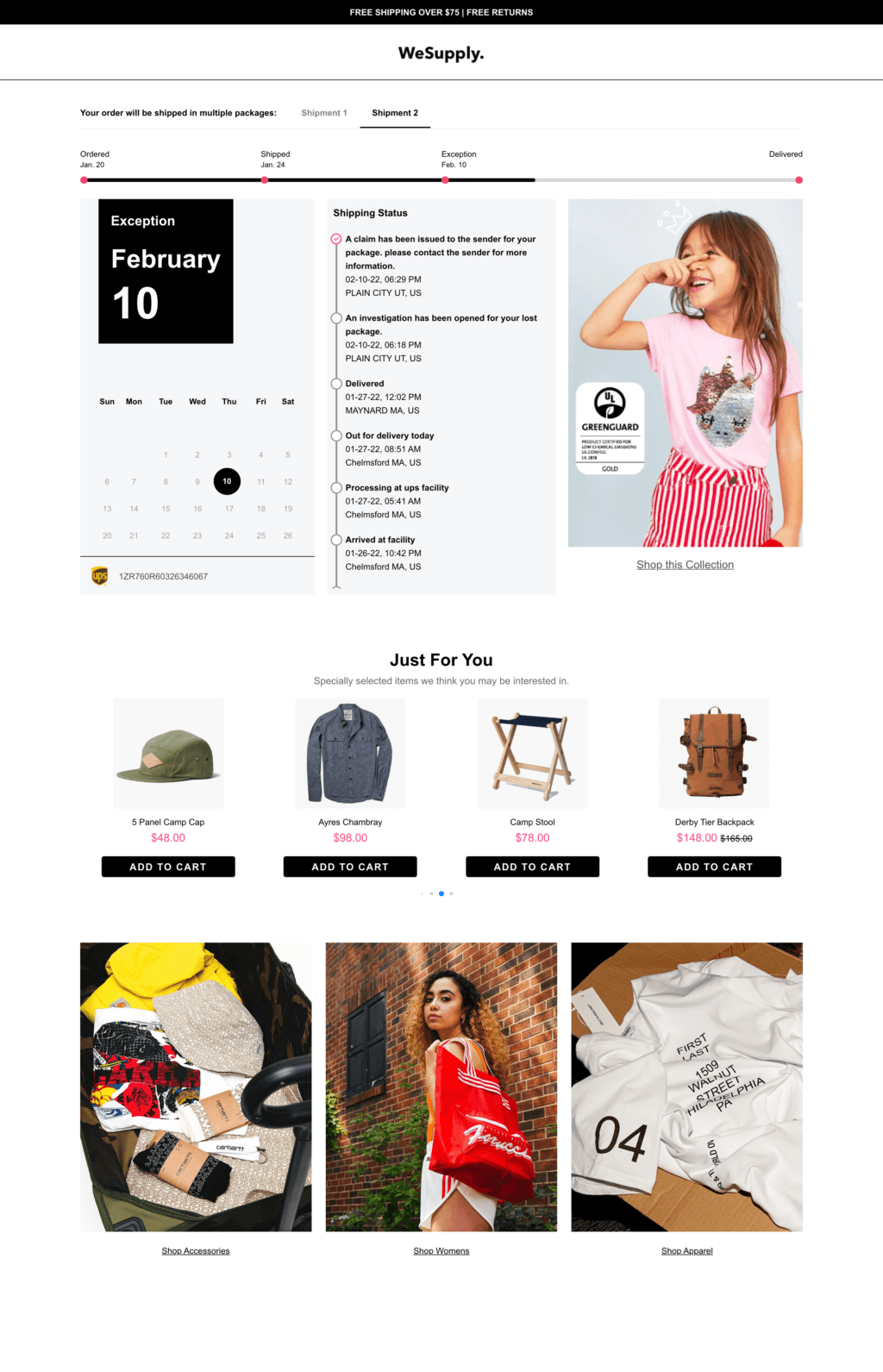
27. Collabs (Influencers/Brands)
Finally, we’ve had a lot of fashion and apparel companies run very successful onsite campaigns featuring collabs. This joint effort can be with a brand that has a complimentary target audience or with an influencer to develop a collection available for a limited time. The two keys to success here are: audience alignment and limited-time access/FOMO.
Collabs can tell a strong visual story which is key for fashion brands and can drive interest/engagement while unlocking new audiences for you. Create targeted onsite lead captures based on traffic source, trigger product recommendations based on behavior, and then re-target those who purchased these exclusive items in the future with campaigns featuring VIP/limited access messaging! A successful collab will leverage several of the strategies outlined above but can be a real revenue source when done right by fashion brands!
Fashion and apparel is a booming e-commerce vertical, and these are just some of the potential strategies to implement when looking to optimize your onsite experience. Justuno is the leading conversion optimization platform for brands when it comes to personalized, scalable onsite messaging, as you’ve seen above.
Try us out with a free 14-day trial or schedule a demo to see how Justuno can take your fashion and apparel brand to the next level.
